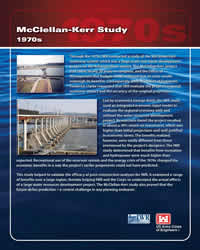
Through the 1970s IWR conducted a study of the McClellan-Kerr waterway system, which was a large-scale river basin development project on the Arkansas River system. The McClellan-Kerr project had taken nearly 20 years to complete, and the Office of Management and Budget (OMB) believed that its costs would outweigh its benefits. Consequently, OMB and Chief of Engineers Frederick Clarke requested that IWR evaluate the project’s regional economic impact and the accuracy of the original projections.
Led by economist George Antle, the IWR study used an integrated economic input model to evaluate the regional economy with and without the water resources development project. Researchers found the project resulted in about a 10% return on investment, which was higher than initial projections and well-justified in economic terms. The benefits realized, however, were vastly different from those envisioned by the project’s designers. The IWR study determined that benefits from recreation and hydropower were much higher than expected. Recreational use of the reservoir system and the energy crisis of the 1970s changed the economic benefits in a way the project’s earlier proponents could not have predicted.
This study helped to validate the efficacy of post-construction analyses for IWR. It examined a range of benefits over a large region, thereby helping IWR and the Corps to understand the actual effects of a large water resources development project. The McClellan-Kerr study also proved that the future defies prediction—a central challenge in any planning endeavor.